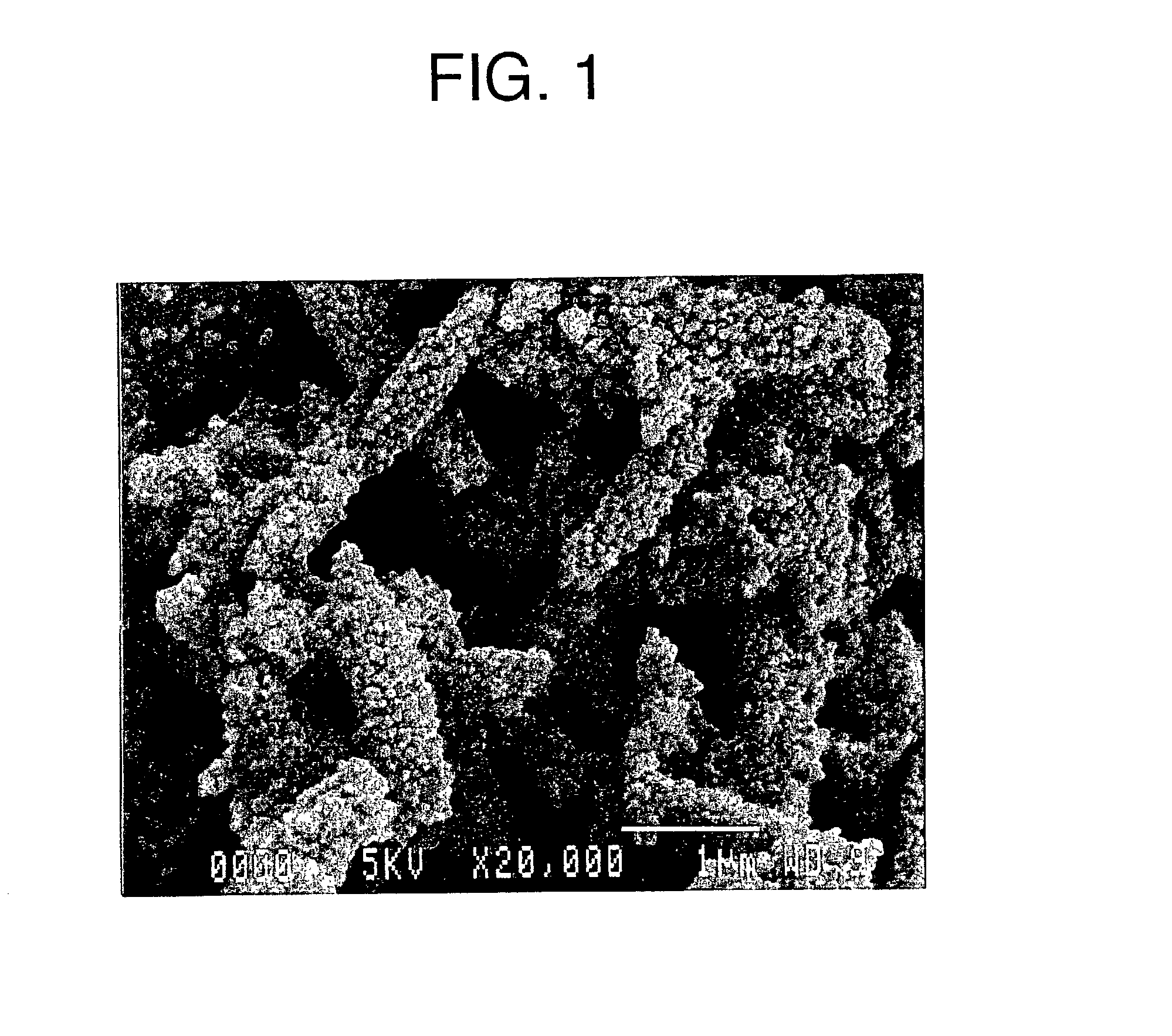Silica-calcium carbonate composite particle
a technology of calcium carbonate and composite particle, which is applied in the direction of magnesium compounds, non-fibrous pulp addition, papermaking, etc., can solve the problems of opacity of printed portions, troublesome ink setting properties, and little reinforcing effect of rubber products obtained
- Summary
- Abstract
- Description
- Claims
- Application Information
AI Technical Summary
Problems solved by technology
Method used
Image
Examples
example 1
[0058] While agitating 2.0 kg of a calcium hydroxide slurry whose temperature was controlled at 30.degree. C. and which had a concentration of 7.4 wt %, a mixed gas of carbon dioxide having a concentration of 25 vol % and air was fed into the slurry at a rate of 1.2 liters / minute per 100 g of calcium hydroxide, thereby causing a carbonation reaction to commence. At the time when a carbonation rate reached 20%, 300 g (calculated as the weight of SiO.sub.2 and corresponding to 30 g per 100 g of calcium carbonate formed) of a 20 wt % solution of colloidal silica (with an average particle size of 45 nm and a spherical shape) was added to and the mixed gas was subsequent fed so as to continue the carbonation reaction, followed by completing the carbonation reaction at the time when the pH of the slurry arrived at 7.
[0059] According to observation through a scanning electron microscope (SEM), the resultant product was made of silica-calcium carbonate composite particles wherein the colloi...
example 2
[0060] While agitating 2.0 kg of a calcium hydroxide slurry whose temperature was controlled at 30.degree. C. and which had a concentration of 7.3 wt %, a mixed gas of carbon dioxide having a concentration of 25 vol % and air was fed at a rate of 1.2 liters / minute per 100 g of calcium hydroxide, thereby causing a carbonation reaction to commence. At the time when a carbonation rate reached 80%, 300 g (calculated as the weight of SiO.sub.2 and corresponding to 30 g per 100 g of calcium carbonate formed) of a 20 wt % colloidal silica (with an average particle size of 45 nm and a spherical shape) solution was added to, and the mixed gas was further fed so as to continue the carbonation reaction, followed by completing the carbonation reaction at the time when the pH of the slurry arrived at 7.
[0061] According to observation through SEM, the resultant product was made of silica-calcium carbonate composite particles wherein the colloidal silica was attached to and fixed on the surfaces o...
example 3
[0062] While agitating 2.0 kg of a calcium hydroxide slurry whose temperature was controlled at 35.degree. C. and which had a concentration of 5.6 wt %, 150 g (calculated as the weight of SiO.sub.2 and corresponding to 20 g per 100 g of calcium carbonate formed) of a 20 wt % colloidal silica (with an average particle size of 20 nm and a round shape) solution was added to. Subsequently, pure carbon dioxide gas having a concentration of 100 vol % was fed from a gas cylinder at a rate of 0.3 liters / minute per 100 g of the calcium hydroxide, thereby causing a carbonation reaction to start, and the carbonation reaction was stopped when the pH of the slurry arrived at 7.
[0063] According to observation through SEM, the resultant product was made of silica-calcium carbonate composite particles wherein the colloidal silica was attached to and fixed on the surfaces of spindle-shaped calcium carbonate particles having a major axis of 1.5.about.2.0 .mu.m and a minor axis of 0.3.about.0.4 .mu.m....
PUM
| Property | Measurement | Unit |
|---|---|---|
| size | aaaaa | aaaaa |
| temperature | aaaaa | aaaaa |
| particle size | aaaaa | aaaaa |
Abstract
Description
Claims
Application Information
 Login to View More
Login to View More - R&D
- Intellectual Property
- Life Sciences
- Materials
- Tech Scout
- Unparalleled Data Quality
- Higher Quality Content
- 60% Fewer Hallucinations
Browse by: Latest US Patents, China's latest patents, Technical Efficacy Thesaurus, Application Domain, Technology Topic, Popular Technical Reports.
© 2025 PatSnap. All rights reserved.Legal|Privacy policy|Modern Slavery Act Transparency Statement|Sitemap|About US| Contact US: help@patsnap.com

